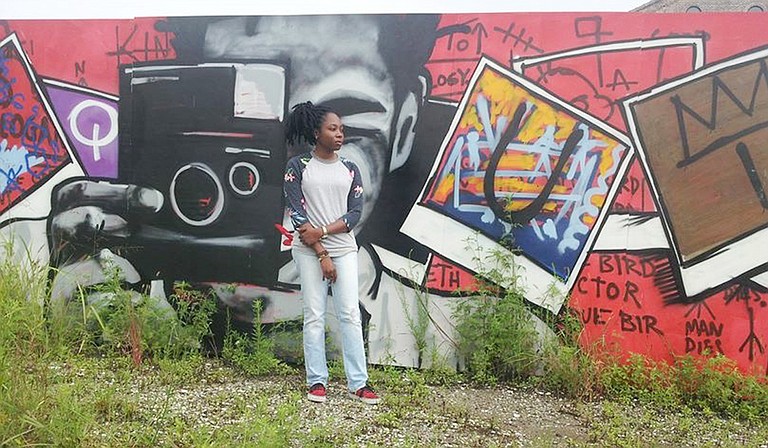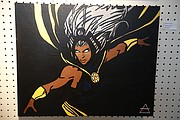Jackson pop artist Adrienne Domnick (pictured in front of a mural in Bywater, New Orleans) often creates pieces that center on artists and musicians that she finds inspiring. Many of them are African Americans. Photo courtesy Mississippi Museum of Art
Wednesday, September 2, 2015
Pop artist Adrienne Domnick, 29, wishes she started doing art sooner. Growing up in Jackson, her mother told her painting wasn't a practical pursuit. After graduating from the University of Southern Mississippi with a bachelor's degree in sports education in 2010, Domnick discovered her that her artwork, which is often colorful, bold and lively portraits of African American artists and musicians, could sell. She draws inspiration from the music she loves and the artists she admires. Domnick recently sat down with the Jackson Free Press at Offbeat in midtown, where she paints, lives and serves as president of the Business Association of Midtown.
When did you know you had a talent for portrait pop art?
It was a Biggie portrait. It was three cardboard pieces I did, just because it was easier to paint on cardboard. That's how I was getting my practice in. And once I did the Biggie and a Janelle Monae, people were asking "Why'd you do this on cardboard? This is good." They asked me for others, and I didn't have any. That's when I start doing more canvas. That's what really started my whole style.
Let's say a person lays a portrait you made side-by-side with the original photograph. What new meaning do you hope people get from seeing your interpretation?
I just want the image to come alive. It's like, I just want to wake the photo up. And if you see my art, if you don't know the person, I want you to want to know the person because you can see the feeling in the photo.
How do you identify who you're going to draw?
It depends. Sometimes it's an image that's just striking to me. The portrait of Miles Davis, for example. The photo alone is like, "Whoa." His eyes are so deep and dark. I really wanted to convey that in the piece. I think he's trying to be spooky. If I can really tell where the light and dark spots are, I will want to draw it. But the majority of the time, it's just the music or just the inspiration of the person I'm drawing that attracts me to it.
Is it the lyrics or the sonic value of the musician's work that inspires you?
It's more production, overall sonically. It's music that, when you look at it, you see colors. And that's real. When I listen to Miles, I see blue.
Lauryn Hill. What color do you see?
Magenta.
Old Dirty Bastard?
I see yellow. For Wu Tang. Killa Beez.
Where do you come across the portraits you paint?
Old books. I love vinyl, too. I get a lot of inspiration from looking at a lot of vinyl. I took inspiration for (my recent pop-up show at the Mississippi Museum of Art) from (a) Marvin Gaye vinyl.
Are you always looking for striking portraits?
I'm never looking for it. The only time I look for it is if I do a commission for someone. Anything I want to do, it just happens to come. I don't search it out. I've been doing artists, but mostly musicians, I really love (painting). Like, I really love jazz, and jazz musicians have the best photos, the best images.
So once you've found the right image, what comes next?
I start with a sketch of the person, and I sketch my way through the dark to leave the light. It's almost like a painting that's not finished. Like, if I were to take these colors and blend it, it would probably look more like the real photo. But instead, I leave some areas solid to show the light and dark.
I noticed you paint many portraits of solemn faces, several of artists who died young. Does a sense of sadness in images attract you to them?
It's just that the dark images come across better for me. I just like the ones where they are just really staring and try to wake the photo up with some color. I like to focus on the sadness in the eyes.
Is there something about the artist's personal experience with struggling that draws you to the people you paint? Like Jean-Michel Basquiat, Hill, Billie Holiday, Nina Simone?
I can't say I can relate to everybody that I paint. I don't have a rough life or anything. But as far as my story as a painter, I felt like it never was going to happen, and it's happening.
To just tap back into it feels good. I think (artists with art degrees) look down on me. That's why I feel I understand what Basquiat went through with people telling him that what he was doing wasn't art.
As president of the Business Association of Midtown, what's your hope for what the neighborhood looks like in five years?
You know, it's turning into what I want it to be. When I first came down here, there was only one building that had art studios. Now, there (are) art studios; there's Offbeat (that) I can walk to; there's a lot of great things going on in terms of creative economy here. I would love to see more artist studios and more artists collaborating—just painting midtown beautiful colors.
What has midtown meant to you?
To be honest with you, I went to Washington D.C., after graduating college and loved the creative energy there. Then I came back home and had a love-hate relationship with Jackson. My studio in midtown made me love my city again.
For more information on Adrienne Domnick, find her art page on Facebook or visit adriennedomnick.com.


Comments
Use the comment form below to begin a discussion about this content.
Sign in to comment
Or login with:
OpenID